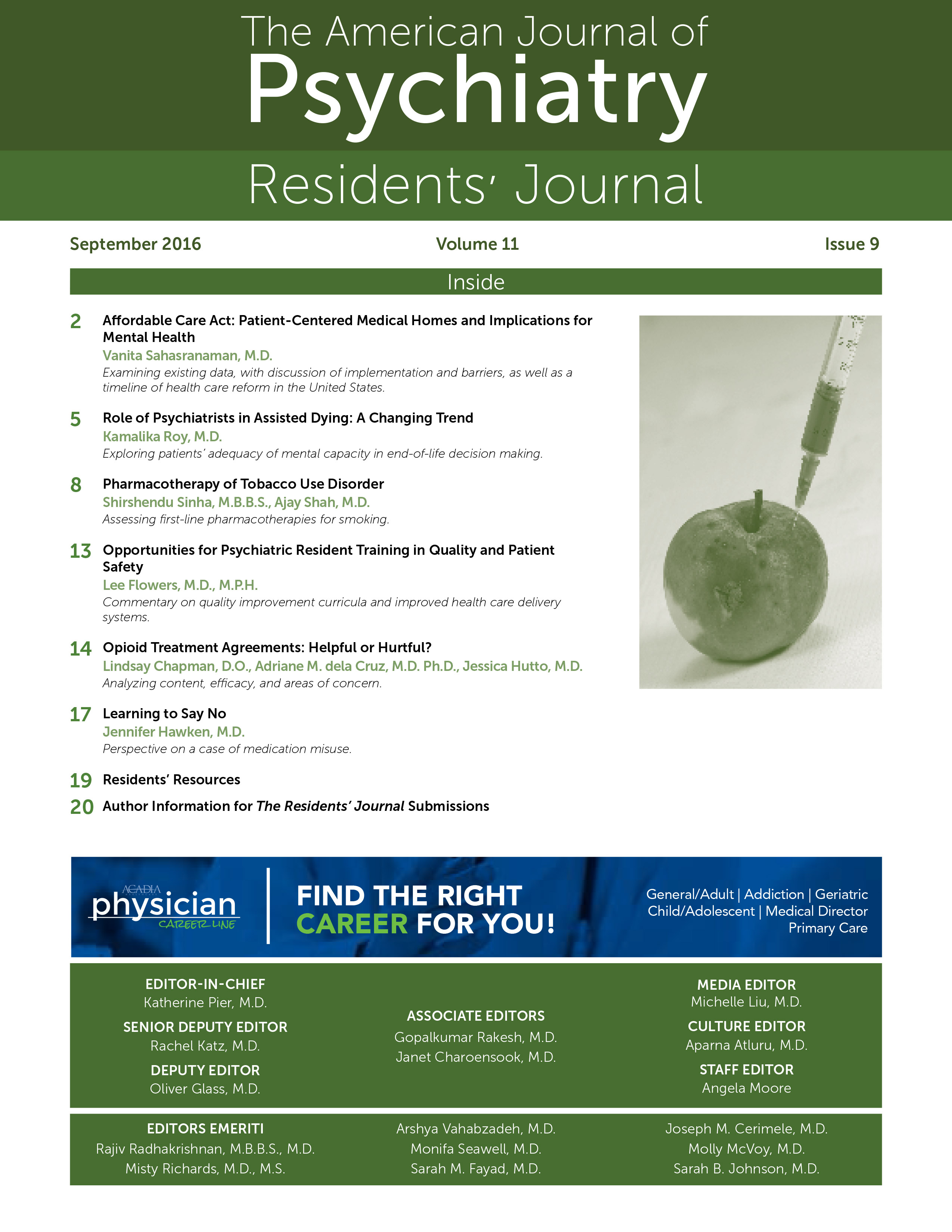Pharmacotherapy of Tobacco Use Disorder
| Drug | Mechanism of Action | Usual Dose | Side Effects | Cautions | Drug-Drug Interactions |
|---|---|---|---|---|---|
| Nicotine gum (over the counter) | Intermediate nicotine absorption, nicotine delivery through oral mucosa, full agonist, reduces cravings and withdrawal | 2 mg or 4 mg | Hiccups, gastrointestinal side effects, jaw discomfort | Pregnancy or breastfeeding; history of systemic rash with nicotine replacement therapy; less than 18 years of age; temporomandibular joint disease; dental or oral problem | None |
| Nicotine lozenge (over the counter) | Intermediate nicotine absorption, nicotine delivery through oral mucosa, full agonist, reduces cravings and withdrawal | 2 mg or 4 mg | Hiccups, oropharyngeal irritation, dry lips, oral ulcers | Pregnancy or breastfeeding; history of systemic rash with nicotine replacement therapy; less than 18 years of age | None |
| Nicotine patch (over the counter) | Slow nicotine absorption; nicotine delivery through skin; full agonist; reduces cravings and withdrawal | 7 mg, 14 mg, or 21 mg/24 hours | Mild skin irritation, nightmares | Pregnancy or breastfeeding; history of systemic rash with nicotine replacement therapy; less than 18 years of age; certain skin conditions | None |
| Nasal spray (prescription) | Fast nicotine absorption; rapidly reduces cravings and nicotine withdrawal | 1 or 2 doses/hour but should not be >5 doses/ hour or 40 doses/day | Mild irritation in nasal mucosa | Pregnancy or breastfeeding; history of systemic rash with nicotine replacement therapy; less than 18 years of age; skin conditions; rhinitis; nasal polyps; sinusitis | None |
| Nicotine Inhaler (prescription) | Intermediate nicotine absorption; nicotine delivery through oral mucosa; full agonist; reduces cravings and withdrawal | 6 to 16 cartridges/day | Oropharyngeal irritation, cough | Pregnancy or breastfeeding; history of systemic rash with nicotine replacement therapy; less than 18 years of age; hypersensitivity to menthol | None |
| Bupropion sustained-release | Norepinephrine and dopamine reuptake inhibition; competitive inhibition of nAChR; reduces nicotine craving; withdrawal, and reinforcement | 150 mg twice daily | Insomnia, dry mouth | Liver disease, renal impairments; seizure disorder in personal and/or family history or with concomitant medications that lower seizure threshold; eating disorders; head trauma with loss of consciousness; pregnancy or breast feeding; less than 18 years of age; taking medications for Parkinson’s disease; history of depressive disorders, bipolar disorders, or schizophrenia; prior adverse reaction with bupropion | Increase risk of seizure with tramadol; can increase tricyclic antidepressant levels. Can be fatal with monoamine oxidase inhibitors via CYP 2D6 inhibition; can interfere with analgesic actions of codeine; can increase plasma levels of some beta-blockers and atomoxetine; can increase concentrations of thioridazine and cause cardiac arrhythmias |
| Varenicline | Partial agonist at α4β2 nAChR; mitigates nicotine craving; withdrawal, and reinforcement | Dose titrated to 1 mg twice daily | Mild nausea, insomnia, nightmares, constipation, possible neuropsychiatric changes (behavioral changes, depressed mood, self-injurious thoughts or behaviors, “boxed warning”); cardiovascular side effects, decreased tolerance to alcohol, rare risk of seizure | Pregnancy or breast feeding; less than 18 years of age; history of depressive disorders, bipolar disorders, or schizophrenia; prior adverse reaction with varenicline | Does not inhibit hepatic enzymes or renal transport proteins; is not hepatically metabolized-unlikely to be affected by other drugs |
| Drug | Mechanism of Action | Study Conclusion |
|---|---|---|
| Clonidine | Alpha2-adrenergic receptor agonist | Small benefit for smoking cessation |
| Nortriptyline | Tricyclic antidepressant | Demonstrated efficacy for long-term abstinence (>6 months) but no statistically significant benefits in adding nortriptyline to nicotine replacement therapy. |
| Cytisine | Nicotine receptor partial agonist | Used for smoking cessation in Europe and Russia. Data are favorable in achieving smoking cessation up to 6 months compared with placebo. |
| Mecamylamine | Ganglionic blocker and noncompetitive antagonist of α4β2 nAChRs | Nicotine patch in combination with transdermal mecamylamine patch or placebo did not demonstrate statically significant improvement in abstinence. |
Nicotine Replacement Therapy
Nicotine Gum
Nicotine Lozenges
Nicotine Patches
Nasal Sprays
Nicotine Inhalers
Pharmacotherapy Not Containing Nicotine
Bupropion Sustained-Release
Varenicline
Conclusions
Key Points/Clinical Pearls
Footnote
References
Information & Authors
Information
Published In
History
Authors
Metrics & Citations
Metrics
Citations
Export Citations
If you have the appropriate software installed, you can download article citation data to the citation manager of your choice. Simply select your manager software from the list below and click Download.
For more information or tips please see 'Downloading to a citation manager' in the Help menu.
View Options
View options
PDF/EPUB
View PDF/EPUBGet Access
Login options
Already a subscriber? Access your subscription through your login credentials or your institution for full access to this article.
Personal login Institutional Login Open Athens loginNot a subscriber?
PsychiatryOnline subscription options offer access to the DSM-5-TR® library, books, journals, CME, and patient resources. This all-in-one virtual library provides psychiatrists and mental health professionals with key resources for diagnosis, treatment, research, and professional development.
Need more help? PsychiatryOnline Customer Service may be reached by emailing [email protected] or by calling 800-368-5777 (in the U.S.) or 703-907-7322 (outside the U.S.).
